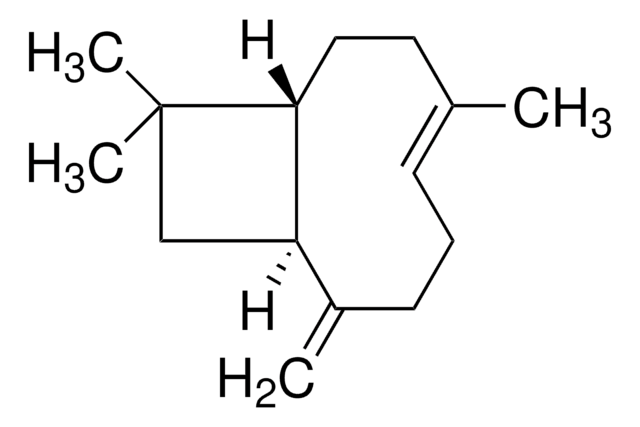Z3902
Zerumbone
≥98% (HPLC)
Synonyme(s) :
(2E,6E,10E)-2,6,9,9-tetramethylcycloundeca-2,6,10-trien-1-one, Zerumbone (6CI,7CI)
About This Item
Produits recommandés
Essai
≥98% (HPLC)
Forme
powder
Couleur
white to off-white
Solubilité
DMSO: ≥10 mg/mL
Température de stockage
2-8°C
Chaîne SMILES
C\C1=C/CC(C)(C)\C=C\C(=O)\C(C)=C\CC1
InChI
1S/C15H22O/c1-12-6-5-7-13(2)14(16)9-11-15(3,4)10-8-12/h7-9,11H,5-6,10H2,1-4H3/b11-9+,12-8+,13-7+
Clé InChI
GIHNTRQPEMKFKO-SKTNYSRSSA-N
Vous recherchez des produits similaires ? Visite Guide de comparaison des produits
Catégories apparentées
Description générale
Application
- for liquid chromatography with mass spectrometry (LC-MS-MS)
- to investigate its potential application in the prevention
- treatment of esophageal squamous cell carcinomas (ESCC)
Actions biochimiques/physiologiques
Mention d'avertissement
Warning
Mentions de danger
Conseils de prudence
Classification des risques
Aquatic Acute 1 - Skin Sens. 1
Code de la classe de stockage
11 - Combustible Solids
Classe de danger pour l'eau (WGK)
WGK 3
Point d'éclair (°F)
Not applicable
Point d'éclair (°C)
Not applicable
Faites votre choix parmi les versions les plus récentes :
Déjà en possession de ce produit ?
Retrouvez la documentation relative aux produits que vous avez récemment achetés dans la Bibliothèque de documents.
Les clients ont également consulté
Contenu apparenté
n proliferating cells, the cell cycle consists of four phases. Gap 1 (G1) is the interval between mitosis and DNA replication that is characterized by cell growth. Replication of DNA occurs during the synthesis (S) phase, which is followed by a second gap phase (G2) during which growth and preparation for cell division occurs. Together, these three stages comprise the interphase phase of the cell cycle. Interphase is followed by the mitotic (M) phase.
Notre équipe de scientifiques dispose d'une expérience dans tous les secteurs de la recherche, notamment en sciences de la vie, science des matériaux, synthèse chimique, chromatographie, analyse et dans de nombreux autres domaines..
Contacter notre Service technique


![[6]-Gingerol ≥98% (HPLC)](/deepweb/assets/sigmaaldrich/product/structures/259/444/6877889c-1cc0-47f5-b807-f847deadec1d/640/6877889c-1cc0-47f5-b807-f847deadec1d.png)








